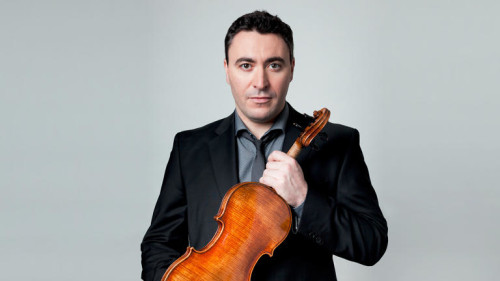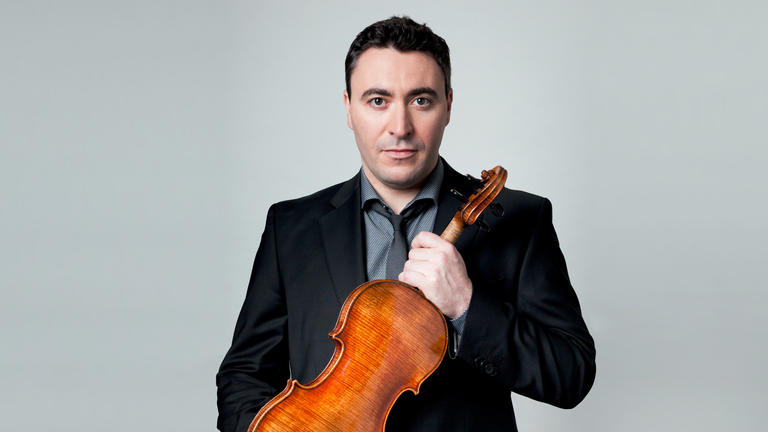 United Kingdom Tchaikovsky, Bruch, Saint-Saëns, Johann Strauss the Younger: Maxim Vengerov (violin), Würth Philharmonic Orchestra, Stamatia Karampini and Maxim Vengerov (conductors). St David’s Hall, Cardiff, 10.6.2018. (PCG)
United Kingdom Tchaikovsky, Bruch, Saint-Saëns, Johann Strauss the Younger: Maxim Vengerov (violin), Würth Philharmonic Orchestra, Stamatia Karampini and Maxim Vengerov (conductors). St David’s Hall, Cardiff, 10.6.2018. (PCG)

Johann Strauss II – Die Fledermaus, Overture
Bruch – Violin Concerto No.1 in G minor Op.26
Saint-Saëns – Introduction and Rondo Capriccioso Op.28
Tchaikovsky – Symphony No.6 in B minor Op.74, ‘Pathétique’
If, like me, you had never previously encountered the Würth Philharmoniker, you may have experienced puzzlement as to whence it originated, and sought enlightenment from the atlas. This, however, would have been so much wasted effort, since – like the Hallé Orchestra in England and the Lamoureux Orchestra in France – the orchestra is named not after any geographical location but after its founder Reinhold Würth, and it has only been in existence for a year or so. This concert formed part of its very first foreign tour. The orchestra is based in Baden-Württemberg, although the programme was remarkably shy about this, but the list of players revealed an impressive list of young international names. Also, the conductors engaged during its first year have included Kent Nagano, Mikhail Jurowski and Dennis Russell Davies, although the Würth Philharmoniker do not as yet appear to have appointed a permanent musical director. This concert was the last date of their tour of Britain (they have a final appearance in Dublin on 12 June) for which the conducting duties were shared between Stamatia Karampini in the first half, and violin soloist Maxim Vergerov stepping up to the podium for the Tchaikovsky Pathétique in the second.
It was immediately clear that the programme was extremely well rehearsed, and the young players made a spectacular showing from the very beginning. The Strauss Fledermaus overture received precise and idiomatic playing, with a proper sense of ‘Viennese lilt’ which at the same time never became an excuse for the rhythmically slovenly delivery which we can sometimes encounter in Strauss. The applause at the end was much more than conventionally polite. And this sparkling opener was succeeded by a real gem in the form of a performance of Bruch’s famous Violin Concerto that entirely lifted the music out of the slough of routine that can sometimes afflict it. Passage after passage came up as fresh as a daisy in Vengerov’s capable hands. He made no attempt to ladle on false excesses of emotion, but expression was present in plenty, and he rode Bruch’s sometimes heavy orchestral textures with absolute assurance and plenty of presence. Following this sensational performance he then explored even more virtuoso territory in Saint-Saëns’s Introduction and Rondo Capriccioso, which he made into much more than simply a virtuoso display or extended encore. As in the Bruch, the orchestral accompaniment under Karampini was spick-and-span and perfectly judged. To cap it all, we then had yet another encore in the shape of a solo Bach Adagio which restored calm before the interval. The audience rightly cheered him to the rafters, giving a thoroughly deserved standing ovation. This was an exhibition of truly remarkable and wide-ranging artistry.
Unfortunately the audience in the second half was not on their best behaviour. The opening of the Pathétique symphony was marvellously sinister – hollow open fifths on the double basses, and a solo bassoon dark as treacle – but within a mere ten seconds hacking coughers were out in force, making not the slightest attempt to mask their unwelcome interruptions, and showing a seemingly total indifference to the atmosphere they were so abruptly disturbing. The whispering bass clarinet solo (rightly transferred from the bassoon) before the eruption of the first movement development was similarly disturbed by a solitary loud cough at least four times louder than what we were hearing from the stage, and under the circumstances it was not surprising that the superbly played development lacked the sense of communicated wildness which it really could have produced. I realise, of course, that an individual member of the audience may be unable to suppress a cough even at the quietest moments of the music; but they could at the very least attempt to stifle the resulting disturbance. I seem to recall many years ago programmes for the Royal Festival Hall in London used to request members of the audience to stifle their contributions with a handkerchief; possibly some such injunction to politeness and consideration for the enjoyment of others might not come amiss at future concerts, too.
Vengerov gave us a fleet-footed traversal of the first three movements of the symphony, again (as in the Bruch) avoiding any temptation to wallow in the sentimentality that can so often afflict performances of the score. He may have missed an element of desperation at the climax of the first movement, but the 5/4 waltz moved at a speed that certainly implied the dance, and in the third movement the lightly pointed string playing provided a featherweight accompaniment to the march theme which gradually dominates the music. At the end of this movement Tchaikovsky specifically does not mark any pause, with the clear implication that after a brief rest of less than a bar the strings should then launch into the despairing opening of the finale, itself a variation on the languishing second subject of the first movement but now marked both lamentoso and largamente. Or at least that is the dramatic effect that the composer clearly intended should happen. Instead, as so often at this point, some members of the audience burst into applause and cheers at what they clearly regarded as the end of the symphony – which goes to show at the very least that they had not purchased, or had not bothered to read, the programme. I do not know what can be done about this, short of a formal spoken announcement at the beginning asking the audience not to do it. But the only alternative is for the conductor to insert an unmarked and unwanted pause at this point, which misses the reasoning behind Tchaikovsky’s instruction but at least ensures that the opening of the finale – with its curious see-sawing effect as the notes of the melody pass from first to second violins and back again – can be heard. What we had here was the worst of all possible worlds; Vengerov plunged straight into the finale, with the result that the opening bars were drowned under applause, and the whole effect was lost (the disposition of the violins, with the seconds placed behind the firsts, would not have helped either). All the expressive playing in the world could not recover the irretrievably lost atmosphere at this point. Which was a pity.
In the past some of the concerts in the St David’s Hall International Season scheduled for Sunday afternoons have been poorly attended (a situation I have ascribed to the poor public transport provision in Cardiff on Sundays) but there was a fairly substantial audience here. I look forward with pleasure to future encounters with the Würth Philharmoniker, and note that their concert schedules next year include appearances with performers as diverse as Heinz Holliger and Sir Andrew Davis. Reviews of earlier concerts in their British tour have been generally favourable (including one from Edinburgh click here), with the Bruch concerto a staple item in the programmes, but with Vengerov generally substituting the Shostakovich Tenth for the Tchaikovsky Sixth.
Paul Corfield Godfrey
